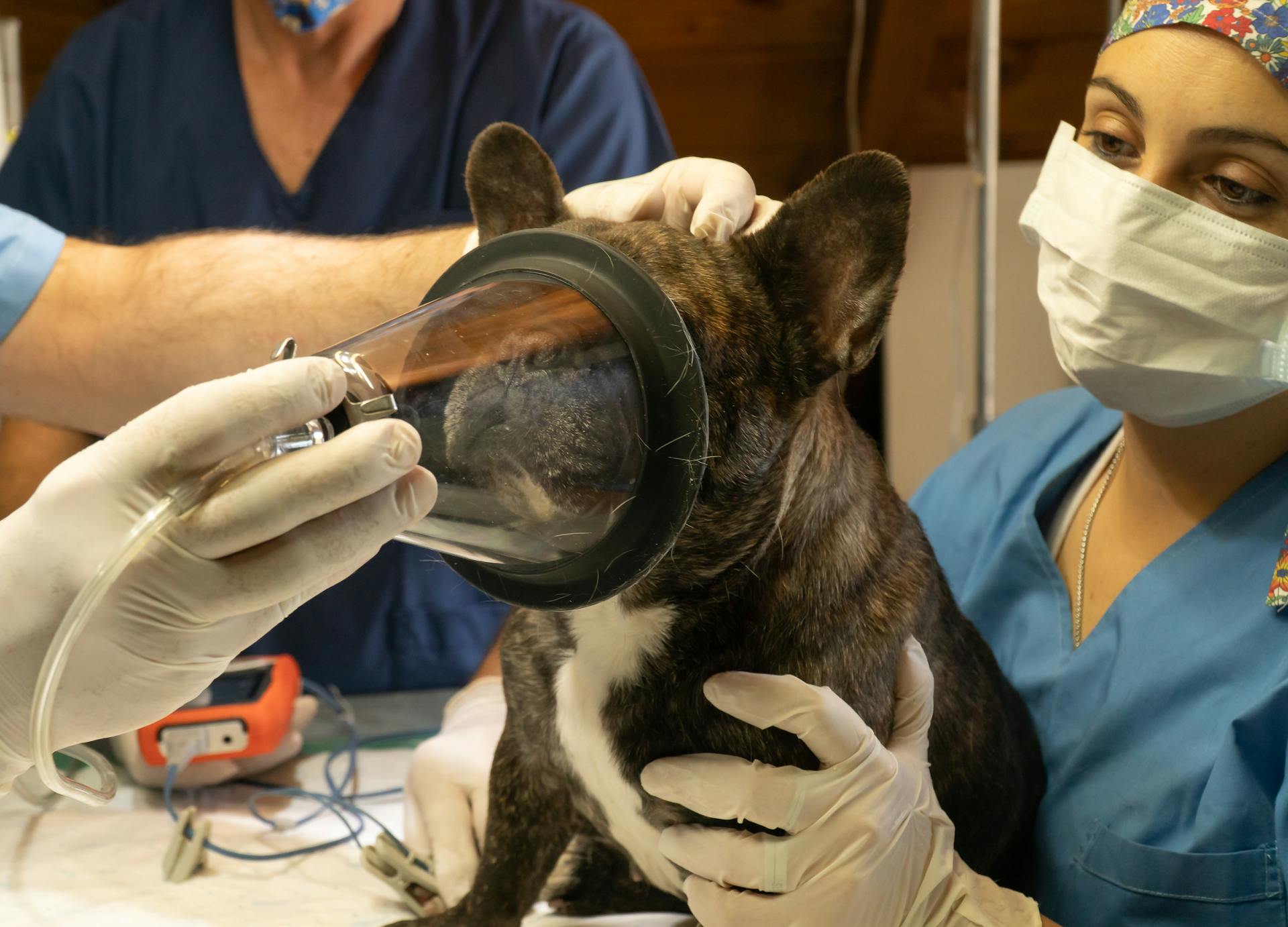
Gastric torsion in dogs is a serious and potentially life-threatening condition that requires immediate attention. It occurs when the stomach twists on itself, cutting off blood flow and preventing the stomach from functioning properly.
Dogs with deep chests, such as those with narrow waists and deep ribcages, are more prone to gastric torsion. These breeds include Great Danes, German Shepherds, and Bulldogs.
The condition can be caused by eating a large meal, especially one that is high in fat, as this can put pressure on the stomach and cause it to twist.
What Is Gastric Torsion?
Gastric torsion, also known as bloat, occurs when the stomach fills with gas, fluid, or food causing it to swell.
The stomach then twists on itself, referred to as volvulus, which can be anywhere from 180 to 360 degrees.
This twisting causes the distended stomach to press onto large blood vessels, disrupting the blood flow to internal organs.
Dogs who experience gastric torsion go into shock quickly.
The swelling can also limit chest movement, affecting breathing.
Dogs at Risk
Dogs with deep chests, such as German Shepherds, Great Danes, Saint Bernards, and Dobermanns, are more prone to GDV.
Male dogs are twice as likely to develop GDV than females.
Dogs over seven years of age are more than twice as likely to develop GDV than those between two to four years of age.
If your dog's chest is deeper than it is wide, you have a dog at increased risk for GDV.
Dogs that have a parent or full sibling with a history of GDV are also at higher risk.
Hunting and guardian breeds, such as German Shepherds and Dobermanns, are over-represented in GDV cases.
If you have a dog that fits any of these categories, it's essential to be aware of the signs of GDV, such as vomiting, restlessness, and abdominal pain.
Additional reading: Are German Shepards Good Family Dogs
Symptoms and Diagnosis
Gastric torsion in dogs is a serious condition that requires immediate attention. Symptoms can develop quickly and worsen rapidly, so it's essential to recognize the signs early on.
Symptoms of a GDV include retching or unproductive vomiting, bloat, restlessness, excessive drooling, collapse, difficulty breathing, and pale gums. If your dog is developing these symptoms, contact your vet right away.
The best way to diagnose GDV is by x-raying the abdomen, but if your dog is severely unwell, they may need emergency treatment first.
Here are some common signs and symptoms of GDV:
- Abdominal distention (swollen stomach)
- Non-productive vomiting (appears to be vomiting, but nothing comes up or only produces white froth)
- Retching
- Lethargy
- Agitation
- Discomfort
- Abdominal pain
- Difficulty breathing
- Excessive salivation
- Weak pulse
- Rapid heart rate
- Pale gums
- Shock
- Collapse
GDV Symptoms
GDV symptoms can develop quickly and get rapidly worse, so it's essential to know the signs to look out for. Retching or unproductive vomiting is a common symptom, where your dog brings up nothing or just a small amount of foam.
Bloat is another symptom, which can be tricky to spot if your dog's tummy is tucked up under their ribcage. Restlessness, panting, and pacing are also signs that something is wrong.
Excessive drooling is a clear indication that your dog is experiencing GDV. Collapse and difficulty breathing are also serious symptoms that require immediate attention.
Here are some common GDV symptoms to watch out for:
- Retching or unproductive vomiting
- Bloat (swollen tummy)
- Restlessness (panting and pacing)
- Excessive drooling
- Collapse
- Difficulty breathing
- Pale gums
If you suspect your dog is experiencing GDV, contact your vet immediately. The faster they receive treatment, the better their chance of survival.
Diagnosis

Diagnosis is a crucial step in identifying and addressing GDV in dogs. The best way to diagnose GDV is by x-raying the abdomen.
Your vet will likely use x-rays to take a closer look at your dog's tummy.
Treatment and Care
Gastric torsion in dogs requires immediate and expert treatment to prevent serious complications and save the dog's life. If your dog has a GDV, your vet will need to reduce bloat and treat shock.
Reducing bloat may involve releasing gas from the stomach, and treatment for shock can include administering fluids and pain relief. Surgery is the only way to fix a GDV, and your vet will check for damage to the stomach and spleen during the procedure.
Surgery typically involves untwisting the stomach, inspecting the surrounding organs, and performing a gastropexy to prevent future twisting. Your vet may also stitch the stomach to the body wall to reduce the chance of it twisting again.
If this caught your attention, see: Vet Approved Homemade Dog Food Recipes for Large Dogs
After surgery, your dog will need to be closely monitored for signs of infection, heart abnormalities, and other complications. Antibiotics and additional medications may be given to prevent or treat these issues.
Some dogs with GDV develop a bleeding disorder called disseminated intravascular coagulation (DIC), which requires management by a pet intensive care unit. Your dog's heart rate and rhythm will be closely monitored throughout their treatment, especially if they already have heart issues.
A typical hospital stay for a dog with GDV is a day or two, during which time your vet will check for further bloating and possible complications. Once your dog is home, you'll need to continue monitoring them for any symptoms of recurring bloat or infection.
Here are some common symptoms to watch out for:
- retching
- unproductive vomiting
- reduced appetite
- high temperature
- restlessness
- collapse
If you're concerned about your dog's symptoms, contact your vet immediately.
Prevention and Cost
Preventing gastric torsion in dogs is crucial, and there are several things you can do to reduce the risk. Restricting exercise for one hour before and after feeding is a good start.
Feeding your dog several small meals a day instead of one large meal can also help. This can be done by dividing their regular meal into 2-3 smaller portions.
Limiting car travel for one hour before and after feeding is also a good idea. This can be done by avoiding long car rides during meal times.
Feeding from the floor is now recommended instead of from a raised bowl, as it reduces the risk of gastric torsion. Encouraging your dog to drink little and often instead of large amounts in one go can also help.
If your dog eats very quickly, consider using a slow feeding bowl or scatter feeding. Separating them during meal times can also help prevent them from racing to finish their food.
Here are some specific tips to help prevent gastric torsion:
- Feed 2-3 small meals a day instead of one large meal
- Limit car travel for one hour before and after feeding
- Feed from the floor instead of a raised bowl
- Encourage little and often drinking instead of large amounts in one go
- Use slow feeding bowls or scatter feeding if your dog eats quickly
Treatment for gastric torsion can become very expensive, so it's essential to consider taking out dog insurance as soon as you bring your dog home. This will give you peace of mind that you have some financial support if they ever become unwell.
Explore further: How Do You Become a Dog Trainer for Service Dogs
Canine Preventatives
Preventing GDV is a top priority for any dog owner. Restricting exercise for one hour before and after feeding can make a big difference.
You should also restrict car travel for one hour before and after feeding to minimize the risk. This means no long drives before meals, especially for breeds prone to GDV.
Feeding several small meals a day instead of one large meal can help prevent GDV. This is a simple change to make, but it can have a significant impact.
Feed your dog from the floor, not from a raised bowl. This advice has changed, and feeding from the floor is now recommended to reduce the risk of GDV.
Try to encourage your dog to drink little and often instead of guzzling large amounts in one go. This can help prevent the stomach from expanding too quickly.
If your dog eats very quickly, consider using a slow feeding bowl or scatter feeding to slow them down. Separating your dogs during meal times can also help prevent them from racing to finish their food.
Here are some key preventative measures to keep in mind:
- Feed 2-3 small meals a day instead of one large meal
- Limit water after meals to prevent stomach expansion
- Avoid vigorous exercise and excitement before and after meals
- Use slow feeding bowls to slow down eating
- Feed bones with caution and monitor closely
Cost

Treatment for a GDV can become very expensive, so it's essential to speak openly with your vet about the cost of treatment and your finances.
Consider taking out dog insurance as soon as you bring your dog home, before any signs of illness start, to give you peace of mind that you have some financial support if they ever become unwell.
When to Contact Your Vet
You know your dog best, contact your vet if your dog is showing any symptoms of GDV. If you're ever in doubt, it's always better to err on the side of caution and reach out to your vet.
If you notice your dog is vomiting, retching, or showing signs of abdominal pain, contact your vet right away. Don't wait to see if the symptoms resolve on their own.
Your dog may also exhibit a distended abdomen, which can be a sign of GDV. If you notice this, contact your vet immediately.
For your interest: Vets Dog Treats
Frequently Asked Questions
How does gastric torsion happen in dogs?
Gastric torsion, also known as bloat, occurs when a dog's stomach fills with gas, food, or fluid and twists, often without warning. This life-threatening condition can progress rapidly, making prompt veterinary attention essential.
What is the mortality rate for gastric torsion in dogs?
The mortality rate for gastric torsion in dogs is 15-20%, varying depending on several factors including the severity of the condition and length of surgery. Understanding the risks and complications can help you make informed decisions for your furry friend's care.
How long can a dog live with a twisted gut?
A dog with a twisted gut can die in a matter of hours if left untreated. Immediate veterinary attention is crucial to prevent a painful and potentially fatal outcome.
How do you tell if your dog has a twisted bowel?
Symptoms of a twisted bowel in dogs include a painful abdomen, restlessness, straining while defecating, bloating, weakness, and loss of appetite. If you notice any of these signs, seek veterinary attention immediately to prevent life-threatening complications
Can a dog with a twisted stomach still poop?
A dog with a twisted stomach may try to have a bowel movement, but it will likely be diarrhea due to the twisted stomach's inability to relieve pressure. This behavior is a sign of a life-threatening condition that requires immediate veterinary attention.
Sources
- https://www.pdsa.org.uk/pet-help-and-advice/pet-health-hub/conditions/gdv-gastric-dilatation-volvulus-in-dogs
- https://www.akcchf.org/canine-health/top-health-concerns/bloat/
- https://animalemergencyservice.com.au/blog/gdv-in-dogs/
- https://tier1vet.com/gastropexy/
- https://newtampapet.com/bloat-surgery-gastric-dilatation-volvulus-gdv/
Featured Images: pexels.com


